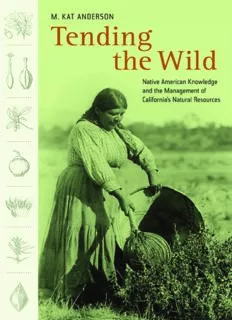
Anderson, Tending the Wild PDF
Preview Anderson, Tending the Wild
Tending the Wild The publisher gratefully acknowledges the generous contribution to this book provided by the David B.Gold Foundation and the General Endowment Fund of the University of California Press Associates. M. KAT ANDERSON Tending the Wild Native American Knowledge and the Management of California’s Natural Resources University of California Press BERKELEY LOS ANGELES LONDON A portion of the royalties go to Native Americans to support the rekindling of their land management practices in certain natural areas of California. University of California Press Berkeley and Los Angeles,California University of California Press,Ltd. London,England © 2005 M.Kat Anderson Parts of chapter 7 appeared in a different form in “The Fire,Pruning, and Coppice Management of Temperate Ecosystems for Basketry Material by California Indian Tribes,” published in HumanEcology27 (1999):79–113,reprinted with kind permission of Springer Science and Business Media.Parts of chapter 10 appeared in a different form in “At Home in the Wilderness,” published in News from Native California6 (1992):19–21,used with permission from Heyday Books and Heyday Institute.Parts of chapter 11 appeared in the article “California’s Endangered Peoples and Endangered Ecosystems,” published in American Indian Culture and Research Journal21 (1997):7–31, reprinted through permission of the American Indian Studies Center, UCLA © Regents of the University of California. Library of Congress Cataloging-in-Publication Data Anderson,Kat,1955–. Tending the wild:Native American knowledge and the manage- ment of California’s natural resources / M.Kat Anderson. p. cm. Includes bibliographical references and index. isbn0–520–23856–7 (cloth :alk.paper) 1. Indians of North America—Agriculture—California. 2. Indians of North America—California—History. 3. Human ecology—California. 4. Nature—Effect of human beings on— California—History. I. Title. e78.c15a676 2005 333.7'089'970794—dc22 2004017995 Manufactured in the United States of America 12 11 10 09 08 07 06 05 10 9 8 7 6 5 4 3 2 1 This book is printed on Natures Book,which contains 50% post- consumer waste and meets the minimum requirements ofansi/ nisoz 39.48–1992 (r1997) (Permanence of Paper). To my parents,Jan and Andy,and to the original teachers—the native plants,animals,and ancestors of California Plants are thought to be alive,the juice is their blood,and they grow. The same is true of trees.All things die,therefore all things have life. Because all things have life,gifts have to be given to all things. WILLIAM RALGANAL BENSON, Pomo, in E.M.Loeb,Pomo Folkways Contents List of Illustrations xi List of Tables xiv Preface xv Note on Languages,Territories,and Names of California Indian Tribes xxvii Introduction 1 PART I. CALIFORNIA AT CONTACT 1 Wildlife,Plants,and People 13 2 Gathering,Hunting,and Fishing 41 3 The Collision of Worlds 62 PART II. INDIGENOUS LAND MANAGEMENT AND ITS ECOLOGICAL BASIS 4 Methods of Caring for the Land 125 5 Landscapes of Stewardship 155 6 Basketry:Cultivating Forbs,Sedges,Grasses,and Tules 187 7 From Arrows to Weirs:Cultivating Shrubs and Trees 209 8 California’s Cornucopia:A Calculated Abundance 240 9 Plant Foods Aboveground:Seeds,Grains,Leaves, and Fruits 255 10 Plant Foods Belowground:Bulbs,Corms,Rhizomes, Taproots,and Tubers 291
Description: